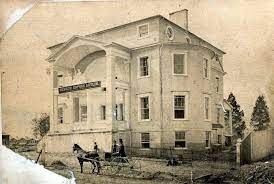Hebrew Orphan Asylum of Baltimore
Introduction
Text-to-speech Audio
This historic building is the former home of the Hebrew Orphan Asylum, Baltimore's Jewish orphanage, which opened in 1875. Planning began around 1872 thanks to several prominent, wealthy Jewish businessmen, mainly of German descent. The orphanage came to be thanks to their planning, donations from the larger Baltimore Jewish community, and a donation of the Calverton Mansion building and grounds by German merchant William Rayner. The mansion burned down in 1874, forcing plans to be changed, but the notable red brick Victorian Romanesque structure was completed the following year. After a period of increased use, thanks to a new wave of Jewish immigrants, the Orphan Asylum closed its doors in 1923 when the government began housing more orphans in foster homes and group homes instead of larger institutions. After serving as a hospital for several decades, it sat abandoned for some time. Today, it has been completely restored and repurposed thanks to Baltimore Heritage and the Coppin Heights Community Development Corporation, who conducted an impressive decade-long campaign to bring it back up to good condition. Today, the building houses a healthcare center and is a local landmark in the city's Jewish history.
Images
Historic Hebrew Orphan Asylum of Baltimore Building

The original building located on this site, the Calverton Mansion. It was donated by William Rayner to be used for the new Jewish Orphanage, but burned down during planning stages, forcing the new building to be constructed.

Backstory and Context
Text-to-speech Audio
The current location of the historic Hebrew Orphan Asylum Building was originally home to the Calverton Mansion, which was built in 1815. Over the years, the mansion passed through a number of hands and was used for different things, most recently as the Baltimore Almshouse. In the 1870s, the Hebrew Orphan Asylum Building came to be thanks to the Hebrew Benevolent Society of Baltimore. This group, which, at the time, was primarily led by Jewish Americans of German descent, set out in 1872 to establish a Jewish orphanage. The grounds of the Calverton Mansion were donated for the purpose by German merchant William S. Rayner with plans to simply move into the empty building, but these plans came to a halt when the mansion burned down in 1874. However, the Benevolent Society did not let this stop them, constructing the Hebrew Orphan Asylum on the same site. While the plans for the new institution were led by wealthy, established German Jews, many supported their endeavor, with the broader Jewish population donating all kinds of amounts and Rayner being an especially outspoken supporter despite not being Jewish himself.
The new building, completed in 1875, is a noticeable, castle-like red brick Victorian Romanesque structure, four stories high. Credit for the design goes to the architectural partnership of German architect Edward Lupus and American-born architect Henry A. Roby. The pair are noted both for their impressive architectural designs and their history of philanthropy within Baltimore's Jewish Community. William Rayner spoke at the dedication, reflecting his hopes and aspirations for the Hebrew Orphan Asylum: “The Jewish community should regard donations as an investment that would bear fruit; some of the children in the future would contribute to the welfare of the community, and the rest would serve as the contributor’s advocates in heaven.”
With a strong community support system, the orphanage did very well in the following decades. Its population grew as immigrants from Germany and Eastern Europe increased in the late nineteenth and early twentieth centuries. Then, from the 1920s through the 1940s, care of orphaned children began to shift away from large institutions to smaller group homes or foster homes. Many older orphanages closed their doors, including the Baltimore Hebrew Orphan Asylum, which closed in 1923. From then, the historic building went through several new owners. First, it was converted by a group of local doctors into the West Baltimore General Hospital, later renamed the Lutheran Hospital of Maryland. It was active through the 1980s before the hospital closed, and the building sat abandoned for a decade. Luckily, it was picked up by Baltimore Heritage and the Coppin Heights Community Development Corporation. The two organizations set out on a successful decade-long campaign to restore the building and preserve it as a landmark of Baltimore's Jewish history. It is thanks to them that the building still stands. Toda,y it houses the Center for Health Care and Healthy Living, which was completed in 2020.
Sources
Pousson, Eli. Hebrew Orphan Asylum - National Register of Historic Places Registration Form , Baltimore Heritage. Accessed March 7th, 2024. https://baltimoreheritage.org/wp-content/uploads/2009/11/bhi_hebreworphanasylum_nrnomination_submitted.pdf.
Rombro, Lorie. A Research Dive: The Hebrew Orphan Asylum, Jewish Museum of Maryland - Herbert Bearman Campus. January 24th, 2018. Accessed March 7th, 2024. https://jewishmuseummd.org/a-research-dive-the-hebrew-orphan-asylum/.
Hebrew Orphan Asylum, Eli Pousson. Accessed March 7th, 2024. https://explore.baltimoreheritage.org/items/show/111.
Wikimedia
Friends of the Hebrew Orphan Asylum
